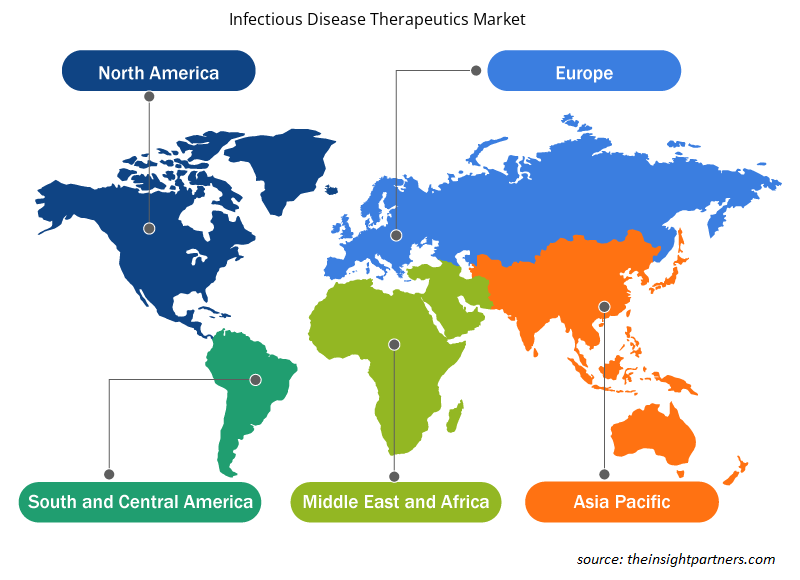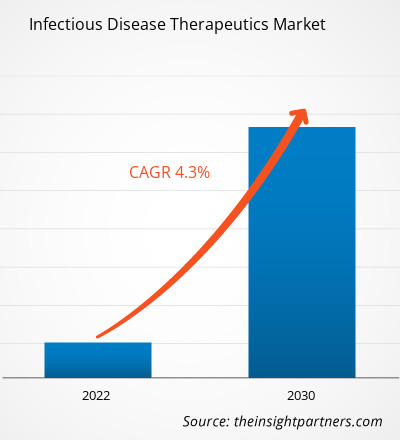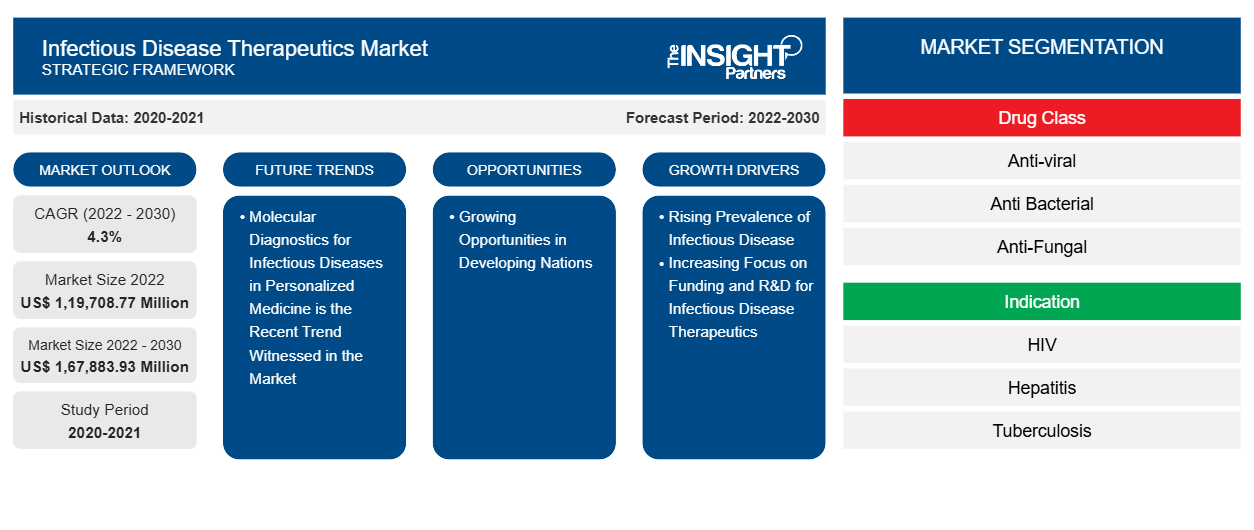2022년 감염병 치료제 시장 규모는 1,19,708.77백만 달러였으며 2030년까지 1,67,883.93백만 달러에 도달할 것으로 예상됩니다. 이 시장은 2022~2030년 동안 4.30%의 CAGR을 기록할 것으로 예상됩니다. 제품 승인 및 출시 수의 증가는 시장의 주요 추세로 남을 가능성이 높습니다.
감염성 질환 치료제 시장 분석
사회에서 감염병이 점점 더 유행함에 따라, 시장 참여자들은 감염병 치료를 위한 첨단 의약품을 출시했고, 정부가 개인에게 감염병 치료를 위한 정교한 시설을 제공하기 위한 이니셔티브를 취하면서 시장이 성장하고 있습니다.
감염성 질환 치료제 시장 개요
박테리아, 바이러스, 곰팡이, 기생충은 모두 감염성 질환을 일으키는 생물입니다. 항생제, 항바이러스제, 항기생충제는 감염성 질환을 치료하는 데 사용되는 약물 중 일부입니다. 감염성 질환 치료제는 유기체에 직접 작용하거나 신체의 면역 체계가 감염과 싸우는 데 도움이 될 수 있습니다. 감염성 질환에는 HIV, 결핵, 말라리아 , 간염, 인플루엔자 등이 있습니다.
귀하의 요구 사항에 맞게 이 보고서를 사용자 정의하세요
이 보고서의 일부 또는 국가 수준 분석, Excel 데이터 팩을 포함하여 모든 보고서에 대한 사용자 정의를 무료로 받을 수 있으며 신생 기업 및 대학을 위한 훌륭한 혜택과 할인 혜택을 이용할 수 있습니다.
-
이 보고서의 주요 시장 동향을 알아보세요.이 무료 샘플에는 시장 동향부터 추정 및 예측까지 다양한 데이터 분석이 포함됩니다.
감염성 질환 치료제 시장 동인 및 기회
감염성 질환 치료제에 대한 자금 지원 및 R&D에 대한 집중 증가로 시장 성장 촉진
연구개발(R&D)은 제약 회사와 바이오제약 사업의 중요한 부분입니다. R&D를 통해 회사는 상당한 의학적 및 상업적 잠재력을 가진 여러 치료적 응용 분야에 대한 신제품을 출시할 수 있습니다. 또한, 선도적인 시장 참여자는 향상된 기술을 개발하고 더 많은 수익 공유를 얻기 위해 R&D에 투자하고 있습니다.
아래 표는 국립보건원(NIH)에서 사용하는 계약, 보조금 및 기타 자금 조달 메커니즘을 기반으로 다양한 질병 범주와 연구에 대한 연간 자금 지원을 보여줍니다.
질병과 자금 조달
질병/연구 분야 |
2019 (백만 달러) |
2020 (백만 달러) |
2021 (백만 달러) |
2022 (백만 달러) |
|
새로운 감염병 |
2,950 |
4,867 |
5,069 |
4,318 |
|
감염성 질환 |
6,313 |
8,301 |
8,599 |
8,019 |
|
성병 감염 |
354 |
394 |
404 |
419 |
참고: 각 통화의 현재 환율이 고려됩니다.
출처: 연례 보고서 및 Insight Partners 분석
제조업체가 자금을 지원한 주요 프로젝트:
• 2022년 6월, GSK plc는 저소득 국가에 불균형적으로 영향을 미치는 감염병에 초점을 맞춘 연구 개발(R&D)을 가속화하기 위해 10년 동안 12억 1,000만 달러(10억 파운드)를 투자했습니다. 이 연구는 말라리아, 결핵, HIV(ViiV Healthcare를 통해), 소홀히 여겨지는 열대성 질병(NTD) 및 항균제 내성(AMR)을 예방하고 치료하기 위한 새로운 의약품과 파괴적 백신에 집중할 것입니다.
• 2022년 3월, 글로벌 펀드의 COVID-19 대응 메커니즘(C19RM)은 캐나다로부터 4,807만 달러(6,000만 캐나다 달러)의 기부금을 받았고, 이는 에이즈, 결핵, 말라리아와 싸우기 위한 글로벌 펀드로부터 칭찬을 받았습니다. 이 새로운 기금은 저소득 및 중소득 국가에 의료용 산소, 개인 보호 장비(PPE)를 포함한 필수적인 치료법과 진단 검사를 제공하는 데 사용되었습니다.
따라서 R&D와 자금 조달에 대한 관심이 높아지면서 감염병 치료제 시장이 성장하고 있습니다.
개발도상국의 성장 기회
감염병의 유병률 증가는 신흥국에서 감염병 치료제 판매를 개선할 것으로 예상됩니다. 데이터 요구 사항이 낮고 법률이 더 엄격하기 때문에 아시아 태평양은 유연하고 사업 친화적인 지역으로 부상했습니다. 게다가 신흥국에서 건강 연구와 생명 과학에 대한 대규모 투자는 개발도상국의 최첨단 기술을 지원하는 데 중요한 역할을 하며, 이는 감염병 탐지 및 치료에 대한 추세를 촉진합니다. 예를 들어, UNAIDS는 저소득 및 중소득 국가의 AIDS 예방 및 치료 요구를 충족하기 위해 2025년까지 290억 달러를 투자할 것을 촉구하고 있습니다. 인도, 한국, 브라질, 멕시코에서는 간염, HAI, HIV, 독감과 같은 감염병이 만연하고 환자 인구가 많으며, 가처분 가능 금액이 증가했으며, 의료 인프라가 개선되었고, 의료 관광이 확대되고 있습니다. 따라서 이러한 국가에서 감염병 치료제 시장을 확대하는 필수적인 감염병 치료제 제품 생산자는 미래에 수익성 있는 전망을 기대해야 합니다.
감염성 질환 치료제 시장 보고서 세분화 분석
감염병 치료제 시장 분석 에 기여한 주요 부문은 약물 종류, 적응증, 투여 경로, 유통 채널입니다.
- 약물 종류에 따라 감염성 질환 치료제 시장은 항바이러스, 항균, 항진균 및 기타로 구분됩니다. 항바이러스 부문은 2022년에 가장 큰 시장 점유율을 차지했습니다.
- 시장은 HIV, 간염, 결핵, 인플루엔자, HPV 및 기타로 세분화됩니다. HIV 세그먼트는 2022년에 시장에서 가장 큰 점유율을 차지했습니다.
- 투여 경로 측면에서 시장은 경구, 비경구, 국소 및 기타로 세분화됩니다. 경구 제조업체 세그먼트는 2022년에 시장에서 가장 큰 점유율을 차지했습니다.
- 유통 채널을 기준으로 감염성 질환 치료제 시장은 병원 약국, 소매 약국 및 기타로 나뉩니다. 병원 약국 부문은 2022년에 가장 큰 시장 점유율을 차지했습니다.
지역별 감염성 질환 치료제 시장 점유율 분석
감염병 치료제 시장 보고서의 지리적 범위는 주로 북미, 아시아 태평양, 유럽, 중동 및 아프리카, 남미 및 중부 아메리카의 5개 지역으로 나뉩니다.
북미가 시장을 지배했습니다. 기술 발전의 채택 증가와 증가하는 연구 개발 활동은 감염성 질환 치료제 시장의 성장을 가속화할 것으로 예상됩니다. 게다가 대규모 의료 사업과 만성 질환과 바이러스성 질환을 치료하기 위한 고급 치료 솔루션에 대한 수요 증가가 이 지역의 시장 확장을 촉진하고 있습니다.
감염성 질환 치료제 시장 지역 통찰력
Insight Partners의 분석가들은 예측 기간 동안 감염성 질환 치료제 시장에 영향을 미치는 지역적 추세와 요인을 철저히 설명했습니다. 이 섹션에서는 북미, 유럽, 아시아 태평양, 중동 및 아프리카, 남미 및 중미의 감염성 질환 치료제 시장 세그먼트와 지리에 대해서도 설명합니다.

- 감염성 질환 치료제 시장에 대한 지역별 데이터 얻기
감염성 질환 치료제 시장 보고서 범위
| 보고서 속성 | 세부 |
|---|---|
| 2022년 시장 규모 | 1,19,708.77백만 달러 |
| 2030년까지 시장 규모 | 1,67,883.93백만 달러 |
| 글로벌 CAGR (2022-2030) | 4.3% |
| 역사적 데이터 | 2020-2021 |
| 예측 기간 | 2022-2030 |
| 다루는 세그먼트 |
약물 종류별
|
| 포함된 지역 및 국가 |
북아메리카
|
| 시장 선도 기업 및 주요 회사 프로필 |
|
감염성 질환 치료제 시장 참여자 밀도: 비즈니스 역학에 미치는 영향 이해
감염성 질환 치료제 시장 시장은 소비자 선호도의 변화, 기술 발전, 제품의 이점에 대한 인식 증가와 같은 요인으로 인해 최종 사용자 수요가 증가함에 따라 빠르게 성장하고 있습니다. 수요가 증가함에 따라 기업은 제품을 확장하고, 소비자의 요구를 충족하기 위해 혁신하고, 새로운 트렌드를 활용하여 시장 성장을 더욱 촉진하고 있습니다.
시장 참여자 밀도는 특정 시장이나 산업 내에서 운영되는 회사나 기업의 분포를 말합니다. 주어진 시장 공간에 얼마나 많은 경쟁자(시장 참여자)가 존재하는지 그 규모나 총 시장 가치에 비해 나타냅니다.
감염성 질환 치료제 시장에서 운영되는 주요 회사는 다음과 같습니다.
- 파이저 주식회사
- 길리드 사이언스 주식회사
- F. 호프만-라 로슈 유한회사
- 시오노기앤코 주식회사
- 바이엘 AG
- 바이오크리스트제약 주식회사
면책 조항 : 위에 나열된 회사는 어떤 특별한 순서에 따라 순위가 매겨지지 않았습니다.

- 감염성 질환 치료제 시장의 주요 주요 업체 개요를 알아보세요
감염성 질환 치료제 시장 뉴스 및 최근 개발
감염성 질환 치료제 시장은 1차 및 2차 연구 이후의 질적, 양적 데이터를 수집하여 평가합니다. 여기에는 중요한 기업 간행물, 협회 데이터 및 데이터베이스가 포함됩니다. 감염성 질환 치료제 시장의 몇 가지 개발 사항은 다음과 같습니다.
- Roche는 CE 마크를 수용하는 국가에서 cobas 5800 시스템에서 사용할 수 있는 최초의 감염성 질환 검사 및 cobas omni-Utility Channel을 출시했습니다. cobas 5800 시스템의 cobas omni-Utility Channel은 단일 플랫폼에서 Roche 체외 진단(IVD) 검사와 오픈 채널 검사를 통합하여 더 광범위한 검사 메뉴를 제공합니다. (출처: F. Hoffmann-La Roche Ltd, 보도자료, 2022년 12월)
감염성 질환 치료제 시장 보고서 범위 및 제공물
"감염성 질환 치료제 시장 규모 및 예측(2020-2030)" 보고서는 아래 영역을 포괄하는 시장에 대한 자세한 분석을 제공합니다.
- 범위에 포함된 모든 주요 시장 세그먼트에 대한 글로벌, 지역 및 국가 수준의 감염성 질환 치료제 시장 규모 및 예측
- 감염성 질환 치료제 시장 동향 및 동인, 제약 및 주요 기회와 같은 시장 역학
- 자세한 PEST/포터의 5가지 힘과 SWOT 분석
- 주요 시장 동향, 글로벌 및 지역 프레임워크, 주요 업체, 규정 및 최근 시장 개발 사항을 포괄하는 감염성 질환 치료제 시장 분석
- 시장 집중도, 히트맵 분석, 유명 업체 및 감염성 질환 치료제 시장의 최근 개발 사항을 다루는 산업 환경 및 경쟁 분석
- 자세한 회사 프로필
- 과거 분석(2년), 기준 연도, CAGR을 포함한 예측(7년)
- PEST 및 SWOT 분석
- 시장 규모 가치/거래량 - 글로벌, 지역, 국가
- 산업 및 경쟁 환경
- Excel 데이터세트
최근 보고서
사용 후기
구매 이유
- 정보에 기반한 의사 결정
- 시장 역학 이해
- 경쟁 분석
- 고객 인사이트
- 시장 예측
- 위험 완화
- 전략 기획
- 투자 타당성 분석
- 신흥 시장 파악
- 마케팅 전략 강화
- 운영 효율성 향상
- 규제 동향에 발맞춰 대응























 무료 샘플 받기 - 감염성 질환 치료제 시장
무료 샘플 받기 - 감염성 질환 치료제 시장